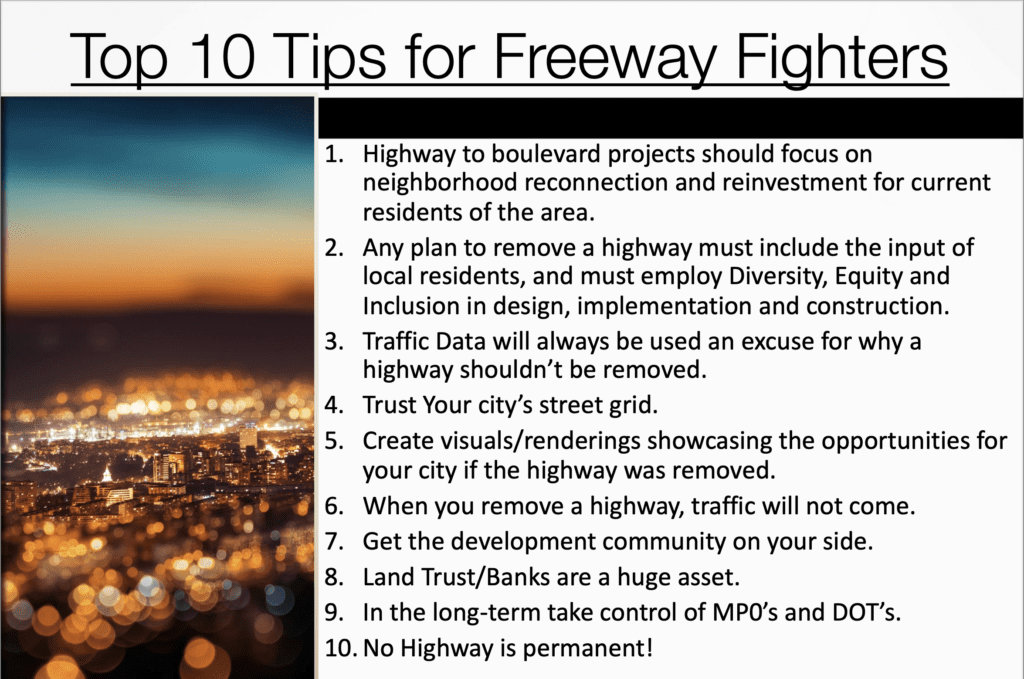An inspiring conversation with organizers of the Freeway Fighters

During the 1950s and 60s, cars presented a shining example of what progress could bring. Cars meant freedom and adventure, not to mention convenience. They needed space and lots of open road. It was under these conditions that freeways and highways became ubiquitous, as city and state governments drew up plans which often sliced through neighborhoods and destroyed local cultural centers. Now, decades later, we can see these impacts clearly — and freeway fighters are trying to undo the legacy of America’s obsession with cars.
Freeway Fighters Across America
In our June 29, 2022 webinar, America Walks celebrated its recent partnership with the Congress for the New Urbanism to host the Freeway Fighters Network. To dive into this topic, we were joined by Amy Stelly, the co-founder of the Claiborne Avenue Alliance, and Jay Arzu, a Ph.D. candidate at the University of Pennsylvania School of Design and a central figure behind the fight against freeways in Rochester, New York.
Both Stelly and Arzu have been fighting to remove existing stretches of freeways that have harmed their communities and brought real-world solutions to those looking to do the same. Though they are working on very different campaigns in very different parts of the nation — New Orleans and upstate New York, respectively — they have both found success. They’ve been mentioned in the New York Times, the Washington Post, their local and national NPR stations, and many more.
They’re in good company, as well. In the last 20 years, dozens of freeways have been removed in cities like Boston, Seattle, San Francisco, and Miami.
How are they doing it? In conversation with America Walks’ Advocacy Manager, Ben Crowther, they discussed their concrete (no pun intended) tips and advice for making this a reality.
Watch the webinar here:
How To Fight A Freeway
Just a few years ago, the idea of removing freeways and highways seemed completely unrealistic – freeway fighters were often viewed as a fringe group. After all, many residents couldn’t understand how their cities would look without the cars whizzing by. How would they get to work? What would it mean for traffic?
“There’s definitely alternatives that we could be looking at,” said Arzu, suggesting that dollars allocated to the construction of new, dangerous highways may be shifted to instead support rapid transit and safety measures on existing streets. “But we’ve got to put pressure on our elected officials, our civic officials, our DOT.”
Unfortunately, even with the burgeoning freeway fighter movement, many elected officials (and residents, for that matter) may not even realize what’s possible, or why people are asking to remove or prevent freeways in the first place. Arzu noted that one critical piece is just sitting with elected officials or their staffers and making sure that they understand “what removing freeways can be, what it can do.”

Top 10 Tips for Fighting Freeways
This is why Stelly leans so hard on earned media as a way to ensure people are learning about the purpose of freeway removal — and why it would benefit them directly.
Another critical piece, says Stelly, is including the neighbors in this fight.
“I live in a neighborhood where planning happens to us, not with us,” she explained.
Arzu added that “we want to make sure the community takes a direct hand in planning the future of the area.” And that means making meetings widely available and accessible, including a lot of community feedback, and really listening to their concerns.
One concern, Arzu says, that he always hears, needs to be put to bed for good: The idea that the traffic of freeways and highways will persist even in their absence.
“Traffic never comes,” he said. “Never.”
And while data often isn’t that convincing, demonstrating the ways that this is true in previous cities and towns which have removed freeways can be beneficial. And for that, there are loads of studies and other information available on the CNU website.
One Freeway At A Time
Freeways have created a caste system within our cities and towns. The public health impacts will linger for generations, as marginalized folks are repeatedly forced to live closer to areas of smog, noise pollution, litter, and tainted water. Additionally, freeways contribute to sedentary lifestyles and make it harder to get around without a car. There is racism baked into our highway system and removing these harmful pieces of infrastructure is necessary if we want to live our anti-racist values.
It can be a hard case to make, though, when freeways are still viewed as essential to our infrastructure.
The promise of the national system of highways was big — but their impact was even bigger, and not in a positive way. In order to accommodate cars, cities and towns cut themselves in half, rendering entire neighborhoods unlivable. And while that may have worked for many people for many years, the times have changed. Climate change, racial inequity, and dire public health conditions brought on by freeways have created an urgency. Thanks to the freeway fighters across the country, the declaration has become louder and more clear than ever before: We must address the damages that freeways have created, one flyover, cloverleaf, and stretch of asphalt at a time.
Join our next webinar July 27th at 2pm ET for a conversation with those in the climate justice movement.